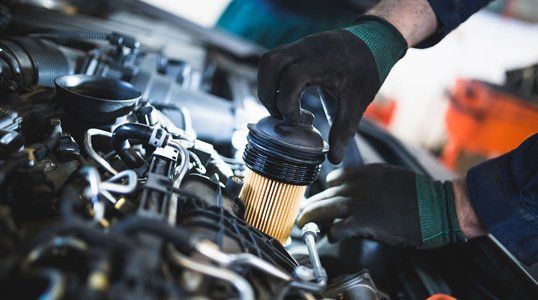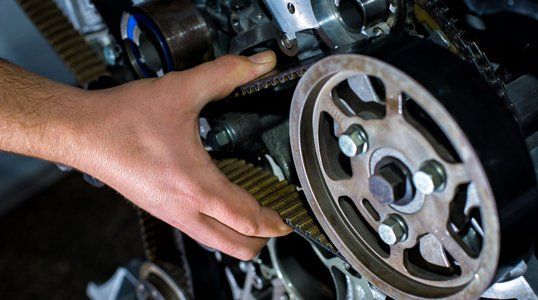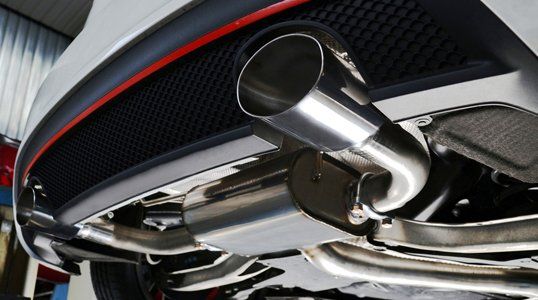Oil, Belts, Air Conditioning
Oil, Belts and Air-Conditioning
Since 2009 | Se Habla Español | ASE Certified
Since 2009Se Habla EspañolASE Certified
Let the Professionals Take Care of Your Vehicle
At E&T Tires and Service, we're experts with belts, air-conditioning and oil changes. Our ASE-certified technicians have the tools and the knowledge to ensure you're safe while driving on the road.
We also know that oil changes are critical to the longevity of your vehicle. Call us
to schedule an appointment. Any questions, we'll return your calls or emails on the same day.

Oil, Lube and Filters
If your driving habits are considered to be "severe service," this type of driving requires more frequent oil changes. You should have your oil changed every 3-5,000 miles. For less wear and tear on the engine, drivers in cold climates (sub-zero driving temperatures) should drop their oil weight from 10-W30 to 5-W30.
- Description: An oil filter consists of a high-strength steel housing containing various types of filtering media. An anti-drainback valve prevents oil from running out of the filter when your engine is off. Today's oil filters have a spin-on design that makes removal and installation easy
- Purpose: Oil filters sift out contaminants, allowing oil to flow through the engine unrestricted. If the oil filter becomes restricted or clogged with contaminants, they will flow around the filter. This bypassing is a safety mechanism. You never want to let oil and filter changes go so long that bypassing takes place
- Maintenance Tips/Suggestions: Consider that your driving probably constitutes a severe maintenance schedule. Usually, this means oil and filter changes every 3,000 miles or 3 months. If you change the filter, dispose of it properly. Take used filters to a facility that accepts them. Used filters can be crushed, removing the used oil and the steel part of the filter can be recycled. The oil from one used filter leaking into a landfill can taint 62,000 gallons of groundwater

Belt and Hose Inspections
Exposure to contamination, heat and vibration makes belts and hoses wear out faster than any other components in your vehicle. Regular inspections are important. Below are the belt and hose types in your car, along with their applications.
Accessory Drive Belts - Some accessories in your car are electrically powered by the charging system, while others use the engine itself as their power source. The power is delivered by a system of pulleys and belts. Examples of these accessories are:
- Alternator
- Water pump for engine cooling
- Power steering pump
- Air-conditioning compressor
- Radiator cooling fan
- Many late model cars use a single serpentine belt in place of individual belts to drive these accessories.
Hoses
- Hoses that convey your car's fluids are made of two rubber layers with a layer of fabric in between. Most hoses include:
- Radiator and Heater Hoses - Convey coolant to the engine and heater core.
- Fuel Hose - This hose transports gasoline from the tank to the engine.
- Power Steering Hose - Connects the power steering pump to the steering gear.

Exhaust Systems
Your exhaust system is more than a muffler. It's a series of pipes that run under your car and are connected to your muffler and catalytic converter. The function of your exhaust system is to control noise and funnel exhaust fumes away from passengers.
A car's exhaust system works like a chimney on your house, directing the byproducts from burning fuel away from the people inside. A car's exhaust system routes waste gases from the engine to the rear of the car, where they are discharged into the atmosphere. These gases contain dangerous substances such as carbon monoxide, which is hazardous if allowed to flow into the passenger housing of the car.
Exhaust systems also convert pollutants into less harmful byproducts, reduces the noise of your engine and directs gases so they can be used to heat air and fuel before they go into the engine's cylinders to be burned.
Exhaust systems also convert pollutants into less harmful byproducts, reduces the noise of your engine and directs gases so they can be used to heat air and fuel before they go into the engine's cylinders to be burned.
Finally, the exhaust system provides the right amount of back-pressure into the engine to improve its fuel-burning efficiency while increases its performance. Key components of your exhaust system include:
- Exhaust Pipes: Designed for each car model to properly route exhaust to the back of the car
- Exhaust Manifold: Like a funnel, collects exhaust gases from all cylinders and releases it through a single opening. Some engines have two
- Catalytic Converter: Reduces the amount of harmful emissions products by transforming pollutants into water vapor and less harmful gases
- Muffler: Metal container with holes, baffles and chambers that muffles exhaust noise.
- Resonator: Works with the muffler to reduce noise
- Tail Pipe: Located at the back of the car, the tail pipe carries exhaust gases away from the vehicle

Air-Conditioning Service
Shifting in your seat, you turn on that AC knob only to discover an unwelcome blast of warm air streaming out from the vents. A bad situation made worse: that's when you turn to E&T Tires and Service!
Without regular maintenance an air conditioner loses about 5% of its original efficiency per year. Without proper maintenance, your air-conditioning unit may be performing as poorly as other models that are years older! You can still recover most of that lost efficiency. Schedule an appointment with one of our factory-trained professionals
Today's AC systems are fairly complex and new improvements are always being introduced. Turn to us for everything related to your air-conditioning system. The following is a brief schematic of some of the basic components that comprise this system:
- Compressor: A belt-driven device that compresses refrigerant gas and transfers it into the condenser. Basically acting as a simple pump, the compressor is the core of your vehicle's air-conditioning system.
- Condenser: A condenser's primary function is to cool the refrigerant. It's a heat dissipating apparatus radiating heat released by compressed gases that condenses them into high-pressure liquids. The location of your condenser is typically found at the front of the vehicle, directly in front of the engine cooling radiator.
- Receiver (drier): The receiver is a metal container that is a storage receptacle for the refrigerant. It's also referred to as a drier because it absorbs moisture from the refrigerant and filters out particles of debris and harmful acids that would otherwise harm your AC system. Usually located on the liquid line of the AC system, you should change your drier every 3-4 years to ensure quality filtration while preventing any damage caused by these detrimental chemicals.
- Orifice Tube/Expansion Valve: The orifice tube (also known as the expansion valve) is a controlling mechanism that regulates the flow of refrigerant throughout the system. It also converts high-pressure liquid refrigerant (from the condenser) into a low-pressure liquid, so it can enter the evaporator. Located at the evaporator inlet, the orifice tube can also be found between the condenser and the evaporator, or in the outlet of the condenser.
- Evaporator: Designed to remove heat from the inside of your vehicle; therefore it's a heat exchanger that's vital to your vehicle's AC system. It allows the refrigerant to absorb heat, causing it to boil and change into a vapor. When this happens, the vapor is removed from the evaporator by the compressor, cooling your car and reducing humidity. Because the evaporator houses the most refrigerant in this heat transfer process, it is the most susceptible to corrosion by harmful acids. Usually this damages the evaporator beyond repair.
Cooling Maintenance System
Let our ASE-certified technicians inspect the components of your vehicle. Their condition will be recorded and compared to manufacturer's specs. Recommendations are made per the Motorist Assurance Program Uniform Inspection Guidelines:
Heating and Air-Conditioning Systems
- Visual inspection
- Interior controls and blower
- Radiator coolant level, hoses, pressure cap and thermostat
- The AC compressor belt for condition and tension
- Leaks or other damage
- Component condition, leaks or damage
Heating and Air-Conditioning Tests
- Pressure test engine cooling system
- AC system pressures are measured and compared to manufacturer's specifications
- AC system is leak tested
- Both the heater and AC are performance tested by checking the outlet air temperature at the discharge vents
Enjoy FREE Wi-Fi while your vehicles gets serviced. We provide same-day service and same-day estimates!
• • • • •
All emails and phone calls are returned the same day!
Oil Change Special
$2.50 OFF
Get $2.50 OFF of an oil change at E&T Tires and Service LLC with this coupon. Up to 5 quarts of major brand name oil, new filter plus vehicle maintenance inspection services. Savings off regular menu price. Not valid with other offers or discounts. Most vehicles. See store for details.
*One use per customer
Click to Use Coupon
EXPIRED
Our Facebook Feed
Contact Us
E&T Tires and Service LLC
712 N Glenwood Avenue
Dalton, GA 30721
Phone:
706-529-5645
Fax:
706-529-4292
Email: ettire@live.com
Privacy Policy
| Do Not Share My Information
| Conditions of Use
| Notice and Take Down Policy
| Website Accessibility Policy
© 2024
The content on this website is owned by us and our licensors. Do not copy any content (including images) without our consent.
